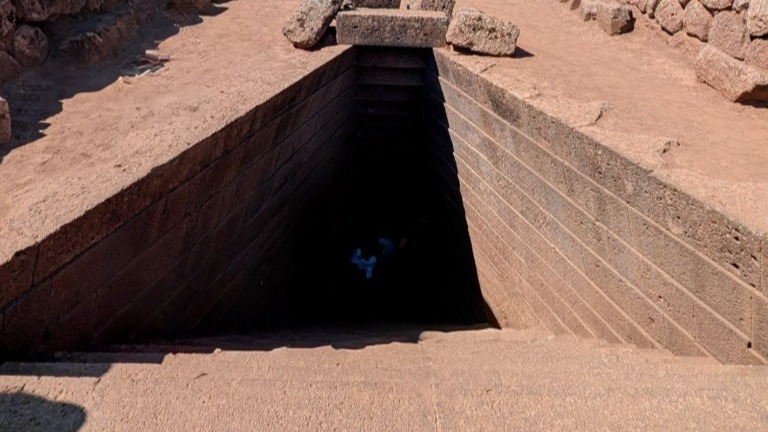There are places that are more than mere stones, walls, or ruins. Places that carry the breath of the past and, with a single glance into their depths, transport us to a world of myths, gods, and cosmic mysteries. One of these places lies hidden in the heart of Sardinia, among gnarled olive trees, where cicadas chirp in the summer chorus and the wind whispers ancient stories: the Pozza Santa Cristina, a sacred well of the Nuragic culture.
A temple in the olive grove
Just a few kilometers south of the village of Paulilatino, a gateway opens into another era. Between the stone remains of a Bronze Age village, surrounded by the pilgrim dwellings of a small church, the path leads into a light olive grove—and right into the spiritual heart of the Nuragic region: the well sanctuary of Santa Cristina.
At first glance, everything seems inconspicuous: low walls of rough stone, an oval enclosure reminiscent of a keyhole. But upon closer inspection, an architectural marvel reveals itself. A precisely crafted staircase of 25 steps leads down into a structure so precise and harmonious, it seems as if it itself were intended to be part of the laws of nature.
The belly of the mountain
With each step down, the staircase narrows—from the open light of the surface to a mystical twilight. The rock moves closer, basalt blocks arch protectively over one another, until the visitor suddenly finds himself in a circular chamber: a subterranean sanctuary, seven meters high, bulbous like the Earth's womb.
Below, the water rests – dark, clear, mysterious. A mirror where heaven and the underworld meet. Above, in the apex of the vault, a small, round hole opens, just large enough for the sun's rays to fall in delicate bundles and refract in the water. Was this a Bronze Age sundial, a gateway to the cosmos? The only thing certain is that the builders knew what they were doing. Their stones speak of knowledge, patience, and a deep respect for the powers of the heavens.
The Miracle of the Moon
And here begins the true fairytale of the Pozza Santa Cristina. Every 18.6 years, as archaeoastronomer Arnold Lebeuf has shown, a spectacle of rare beauty occurs: At the great northern lunar solstice, the light of the full moon falls into the shaft at an angle of 29 degrees—so precisely that it illuminates the pool without touching a single step. For a moment, the full moon is reflected in the spring, as if it itself had kissed the earth.
Three thousand years ago, this spectacle was perfect – today, the moonlight only touches the lowest steps, a faint reminder of a time when sky and stone were in harmony. But anyone who has ever experienced a full moon over Santa Cristina senses that magic is not lost here, but lives on – in light and water.
Cult site for millennia
The sanctuary of Santa Cristina was not just a fountain—it was the center of a cult that linked water, fertility, and cosmic order. Bronzes found here suggest that the site was venerated until the 1st millennium BC. Even the Carthaginians, later rulers of Sardinia, made offerings here; their incense burners are silent witnesses to a spiritual continuity.
And Christianity hasn't forgotten the place either. It's no coincidence that the small church of Santa Cristina stands right next door – as so often happens, old cults merged with new forms of faith, and the spring remained what it always was: a holy place.
A place to listen
Those who make a pilgrimage to Pozza Santa Cristina today experience more than just archaeological fascination. A quiet magic is at work here: the creaking of the olive trees, the whispering of the wind over the walls, the darkness of the fountain, in which the sky is sometimes still reflected.
Here, deep in Sardinia, you realize: There are places that are bridges. Between past and present, earth and cosmos, humanity and God. Santa Cristina is one of them. A fountain that collects stories – and carries them forward in the water.
Anyone visiting Santa Cristina should take their time – not just for the stairs leading down into the valley, but also for the small nuraghi, the remains of huts, and the circular temple that bear witness to the 14-hectare site. A stroll through a Bronze Age village that still evokes the heartbeat of its inhabitants.
Light Gallery cannot find your image path: images/unterwegs/202508santacristina!


